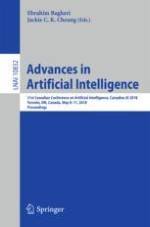2018 | Buch
Advances in Artificial Intelligence
31st Canadian Conference on Artificial Intelligence, Canadian AI 2018, Toronto, ON, Canada, May 8–11, 2018, Proceedings
herausgegeben von: Ebrahim Bagheri, Jackie C.K. Cheung
Verlag: Springer International Publishing
Buchreihe : Lecture Notes in Computer Science
